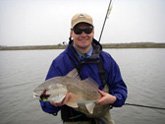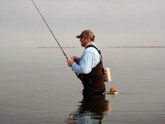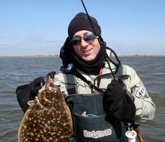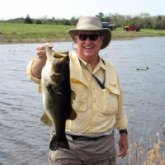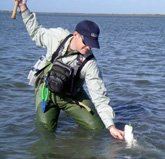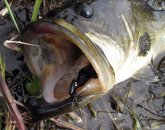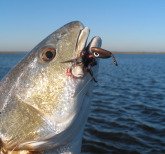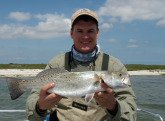Marsh Fishing Tips
Marshes are the best places to chase redfish along the Gulf Coast and these Marsh Fishing Tips will help you target specific areas in your kayak or poling skiff. You'll start on your computer of all places using a handy little tool called Google Earth. This will help you locate the most likely places to find redfish. And when you find them, the second half of these marsh fishing tips will tell you how to catch them based on their behavior and what lures to use. All this information comes from Sonny Mills, who has years under his belt kayak fishing the Texas Gulf Coast. But don't let Texas scare you off, because these marsh fishing tips will work anywhere redfish are found in skinny water.
We're glad to welcome Sonny Mills as a Buggs Fishing online contributor.
I've known Sonny indirectly for a couple years now through his posts
on a TexasKayakFisherman.com, a popular forum. I enjoy reading his
posts and learned he was a fan of Buggs. I also found out he had a
straight forward and informative writing style, and was more than
willing to share his fishing experiences with others. He started a blog
not long ago, and when I saw this post I was very impressed. Read on
to learn some very valuable marsh fishing tips. - Heath
I’ve been getting a few PMs and e-mails recently asking different questions about how I fish a marsh and some general marsh fishing tips. Anything from what to look for, how I choose where to go, what baits to use, etc. I decided to try and put all of this information together in one spot. I can remember searching the internet for marsh fishing tips and other information when I first started fishing the marsh. I had a hard time locating anything useful. Hopefully the information provided on the next several pages will be valuable to those interested in catching redfish in shallow marshes.
I do want to point out that my approach towards fishing a marsh is not the only way nor is it necessarily the right way. It just happens to be the method I use because I have had success with it over the last few years and I really enjoy this style of fishing more than others. As I gain more knowledge and experience over time I’m sure I will change my opinion and approach on many of the following methods.
Marsh Fishing Tips - Locating a Marsh
Google Earth is one of the best resources for people that fish shallow
marshes. It allows you to discover new areas that you would have never
found otherwise while sitting in front of your computer. It also lets
you zoom in and get a good view of an area before you even make your
first trip. I've spent a countless number of hours looking at areas all
along the upper Texas coast that I believe are worth exploring. Shallow
marshes will show up on Google Earth as a lighter brown color when you
zoom in because the water is so shallow you are seeing the mud bottom. A
bay or deeper body of water will appear as a green or blue color.
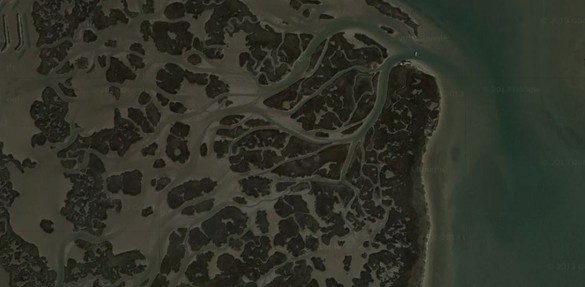
Once I have found a marsh I will login to my Google account and on the maps page click on “My Places” and then “Create Map”. From there I will name the map and start marking certain areas that I believe are worth checking out so that I can save them and view later if needed. These areas could be patches of shell, deeper guts, drains, or any other areas that I think look promising. So the first of the marsh fishing tips is to do your research beforehand so you know where you're going. You'll give yourself the best chance of finding and catching redfish. Next we're going to talk about these areas in more detail.
Shell
Patches of shell will show up as tiny dots that can be a lighter or darker color on the map. It’s good to make a note about the location of shell because you will probably be trying to fish around it or keep away from it so that you don’t tear up the bottom of your kayak. Either way it’s important to know its location.
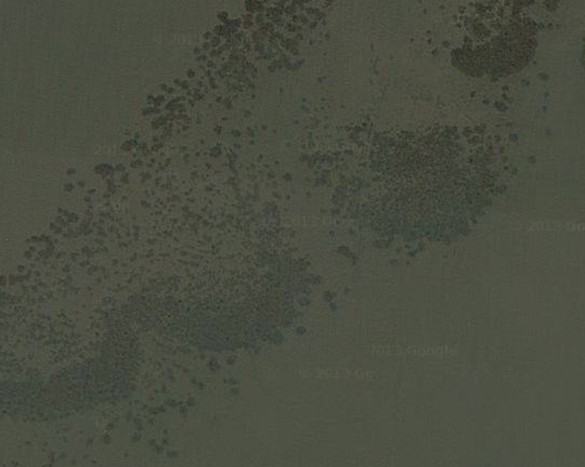
Guts
Deeper guts will be a darker blue or green color. The reason a gut shows up as this color in the marsh is because it is at least a few feet deep so the satellite is capturing the water in the image and not the mud bottom. On a really low tide this will be an area that a lot of redfish will stay in or at least close to.
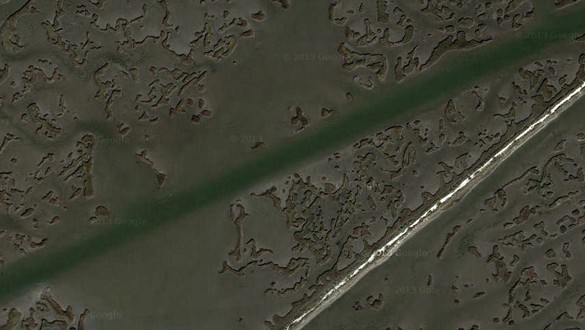
Drains
Drains are areas where faster moving water is being released after it has been funneled through a narrower channel or pinch. Most of the time a good drain will be a deeper area that is similar to the guts mentioned above due to the heavy flow of water digging the area out over time. I like to look for multiple channels or pinches that are emptying into the same location and have formed a deeper gut. Reds, trout, and flounder will stack up in these areas on a moving tide. They're waiting for baitfish and shrimp that have been caught in the current to come by for an easy meal.
Good marsh fishing tips to remember are that drains can be productive on both the incoming and outgoing tide. Drains are normally the only areas that I will stop and blind cast into. When fishing a drain that has a depth of at least a couple feet I like throwing a popping cork with any of the popular scented soft baits like Gulp!. You get the chugging sound, smell, and the ability to keep the bait suspended in a certain area. This is a great way to pick up fish.
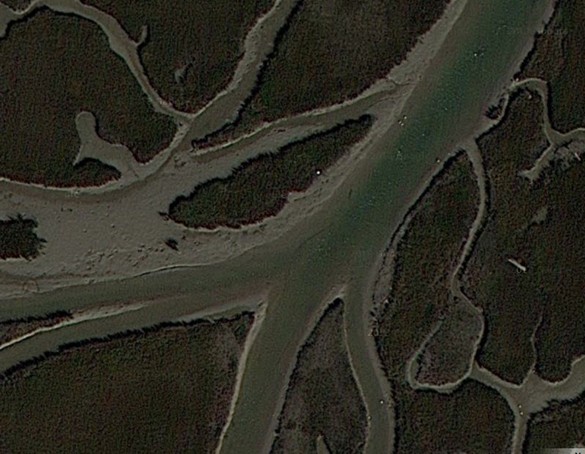
Hopefully these marsh fishing tips can help you locate a few new areas to explore and fish. Knowing as much about an area as you can before arriving gives you a better opportunity to have a successful trip. Below are different things I look for and the types of baits I like to throw in certain situations.
Marsh Fishing Tips - What To Look and Listen For
Your eyes and your ears are two of the most important tools you have while fishing a shallow marsh. Redfish that are in a foot or less of water have several ways of giving themselves away if you know what to look and listen for. For this reason I probably spend more time paddling than fishing on most days. I am constantly moving around looking for a reason to pick up my rod and make a cast. If I don’t see or hear anything that lets me know a fish is in the area then I like to stay on the move. The only time I ever stop to blind cast an area is when I come to one of the drains mentioned on the previous page.
The next marsh fishing tips are different signs I am constantly looking
and listening for while moving through the marsh. I have also included
the lure I prefer to use depending on the situation.
(I left the advice
on lures untouched except to exclude specific brand names. I didn't
add Buggs to any of the following lists where Sonny hadn't already
listed them. I'm certainly biased towards Buggs, but will freely admit
that there is more than one way to skin a cat / catch a red. - Heath)
Birds
When the birds are working they can be one of the easiest ways to find
redfish. They will normally be hovering about 10 feet or less above the
water and occasionally dropping down to pick up the small baitfish or
shrimp that the reds may have missed. They will move at the same speed
the pod does which is normally not too fast. Sometimes it may be a
single bird or it could be several dozen pointing them out. On occasion,
when you approach the pod the birds will clear out and you will be left
to locate the pod on your own. Marsh fishing tips here are to always
make note of the direction they are heading, and keep an eye out for
tails and heads breaking the surface of the water along with bait
scattering.
Preferred Lure: I will normally throw any soft plastic on a
1/16th ounce jig head a few feet in front of and past the pod and work
the lure back in front of them. Try not to hit a bird.
Pods
Not all pods of redfish will have birds on top of them. Pods may consist
of a few reds cruising a shoreline or more than a hundred out in the
middle of an open lake. When they pod up like this they are eating
everything in their path and it basically becomes a contest to see which
redfish can eat the bait first. For this reason, catching a red from a
pod is about as easy as it gets. The marsh fishing tips here are to
throw a few feet in front of and past the pod and work the lure back
into their path. However, a bad cast that lands in the middle of the pod
is normally taken without spooking them. You will normally see their
heads or tails breaking the surface of the water and/or hear a distinct
popping noise. Sometimes a pod will break up when you pull a fish from
it and sometimes it will keep moving as if nothing happened. It’s
possible to catch multiple fish from one pod if you’re quick enough. If
the pod does break up they will sometimes regroup so its important to
watch the direction they scatter in.
Preferred Lure: As mentioned above, a soft plastic on a light jighead will work well.
Crawlers
When the tides are really low you will have a chance to see redfish “crawling”. This normally occurs in a few inches of water and results in seeing the entire redfish from head to tail. It’s definitely one of the most exciting things you’ll see in the marsh but the drawback is that they are normally very spooky when this shallow.
The marsh fishing tips for these crawlers are to use a lighter bait and
cast several feet past the fish. Then you work the lure towards it very
slowly. It helps to have a lure here that will just sit on the bottom,
hook point up so it doesn't snag. And being able to slightly twitch
the lure and it look alive is definitely a plus.
Preferred Lures: My favorite lures in this situation are Buggs
Curl-Tail Jigs or Beastie Buggs. They land very softly and look great
when you hop them along the bottom.
Tails
Just like crawlers, when redfish are tailing they are normally in very
shallow water. Most fish need to be in a foot or less of water before
you are able to see them tail. If you see a tail sticking up then the
redfish is digging through the mud for crabs, worms, shrimp, or anything
else it can stir up.
Preferred Lures: Similar to crawlers, tailing fish can be a bit
skittish at times. I like to use a Buggs Lure or and soft plastic on a
1/16th ounce jighead.
Blow Ups Through Bait
When redfish are in shallow water and attacking bait they will dart
through the water and cause a pretty large splash and/or wake. A lot of
the time you will hear this before seeing it unless you happen to be
looking in the right direction at the right time. The marsh fishing
tips here are to recognize these sounds. The sound made will be a
deeper flush type noise that is noticeably different than the sound made
by the larger horse mullet when they jump. After a while it becomes
fairly easy to recognize the difference between the two.
Preferred Lure: Any bait you choose will work well when they are
feeding this aggressively. I like Buggs, soft plastics, shallow diving
crankbaits and wake baits in this situation.
Baitfish Scattering
When a predator is in the area and baitfish feel threatened they will
ball up and try to seek protection in numbers. When a redfish darts
through a ball of bait they will scatter in every direction leaping out
of the water to escape. If you see multiple baitfish going airborne you
can be sure something is under or around them. If you see little flashes
of light in the distance its possible you are seeing the sun reflect
off the baitfish as they jump out of the water.
Preferred Lures: Shallow diving crank baits or a wake bait will
work well in this situation. Shad tail soft plastics on a lighter
jighead are another favorite of mine.
Wakes
Redfish cruising a shoreline or open lake will make a small wake if they
are shallow enough or near the surface of the water. A small “V” will
form as the red moves around and will normally trail the fish for a few
feet. It should be noted that larger mullet and small pods of baitfish
can do this as well. Over time it becomes easier to tell the difference
between the two.
Preferred Lure: Anything you choose will work well in this
situation. Just make sure the lure gets a few feet in front of and past
the fish and then work it back so that they eventually meet up.
Blowouts and Mud Boils
When a red is spooked in the marsh and a “blowout” occurs it will
normally leave a relatively straight wake that will be 5 to 20 yards
long moving about 90 mph. You will also see mud boils which will look
like little clouds of smoke under the water. If you see mud boils then
redfish are more than likely in the area.
Preferred Lure: The majority of the time a redfish isn't
interested in eating once it is spooked and blows out but on occasion a
well placed lure will be taken.
Marsh Fishing Tips - Advanced Techniques
Jumping Shrimp
Shrimp jumping near a grassline is one of the harder things to spot even
if you’re constantly scanning the shoreline. As redfish move down a
shoreline they are trying to spook shrimp and other baitfish from the
grass and mud. When a redfish moves over a shrimp that his hiding in the
mud or grass it will try to escape and many times leap out of the water
to avoid being eaten. They don’t really make much of a splash or noise
when they jump so you really have to be looking for the slightest bit of
movement. Sometimes you’ll see a shrimp jump every couple of seconds a
few yards apart and that will show you the direction the fish or pod is
heading.
Preferred Lure: A soft plastic shrimp imitation on a light
jighead put a few feet in front of the fish will work well. Just give a
few slight twitches when the fish is about a foot away.
Grass Twitches
Probably the most difficult sign to notice are grass twitches. When the
tide is high in the marsh redfish will move into the grass searching for
food. You probably won’t see too many tails, crawlers, or wakes on days
like this. However, as they are moving in and out of the grass they
will bump into it causing very small but distinct twitches. The marsh
fishing tips here are encouragement to pay close attention to your
surroundings when paddling or poling through the marsh. Oftentimes
you've done a great job scouting an area but the tide is higher than you
expected. Slow down and really look for scattering shrimp, baitfish,
and these grass twitches. You just might get rewarded!
Preferred Lure: I like any soft plastic on a 1/16th ounce jighead or Bugg in this situation.
All of the above mentioned signs are things that I am constantly looking for as I move around a marsh. I have caught fish using each of these marsh fishing tips and have spent a lot of time on the water training my eyes and ears what to look and listen for. - Sonny Mills
Marsh Fishing Tips - Conclusion
I hope you enjoyed reading these marsh fishing tips by Sonny Mills. We are thankful that he's shared them, and hope he'll be a regular contributor to the Buggs website.
Follow the link to Sonny's blog for more tips on saltwater kayak fishing.
Home > Fishing Tips > Marsh Fishing Tips

